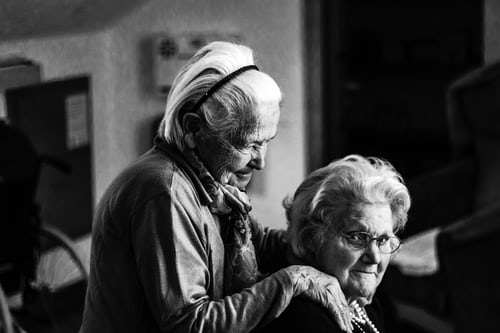There is much focus within Social Value methodology on young people. And it’s obvious why this is the case. Younger people have been disproportionately economically disadvantaged by Covid19. They are also the future of our workforce and as such it’s right that employability programmes positively discriminate to create the brightest futures for our young people.
But we live in an aging society, a fact that is becoming harder to ignore. It is anticipated that one in five people will be 65 or over by 2030. The 85+ age group is the fastest growing and is set to treble by 2066 (7% of the population or 5.1m people).
In the past year older people have had their health disproportionately affected in the same way as young people have been economically disadvantaged. 9 out of 10 people who have died of Covid19 were over the age of 65, and 1 in 4 of those had dementia.
But the saddest fact is that 2 out of 5 people who died were living in a care home, and are likely to have been isolated from loved ones. Age UK has a great deal to say on this subject, considering that “institutionalised disregard for older people and enormous ignorance about their lives” has been displayed.
This is just an example of the ignorance that most working age people experience regarding older people’s lives. Let’s face it – we don’t like to think about being old. It is an uncomfortable truth that we will all age and die. And as a result, our own loved ones aside, most of us don’t spend a lot of time around elderly people.
The reality is that people living on a state pension represent some of the poorest in our society, with no visibility, little economic power and limited voice. At the same time, other ‘Baby Boomers’ find themselves the wealthiest generation ever, creating massive disparity between elderly haves and have nots.
But money, ultimately isn’t everything. Many old people find themselves without anyone to care for them as they become increasingly frail. Of the nine million lonely people in the UK, four million of these are older people.
So how do we move forward and where does social value fit?
We need to start thinking of older people as an underrepresented group. In the same way that we can target initiatives towards long term unemployed and disabled, we can think about engaging with the elderly.
TOMs indicator NT27 encourages that ‘Vulnerable people are helped to live independently’, and there will always be community based initiatives you can support. However, also think about your embedded impact, i.e. your operational practices.
B&Q has led in the area of employment for older people for several years. The company doesn’t have a default retirement age, as of 2011 had 28% of its workforce over the age of 50 and employs people on flexible, semi-retired options. Providing someone living on a state pension the opportunity to be employed on a part-time basis could be the difference to lift someone from below the poverty line.
Flexible working practices also support and enable staff members providing care to elderly friends and relatives. This in turn helps older people to live independently for longer, which is better for them, reduces the burden of state care and enables our taxes to be spent on other areas of need.
Social Value currently focuses training on young people and those in employment, but there are as valid reasons for supporting training of older people, particularly around digital skills -enabling older people to have an online presence – accessing digital health and financial services and staying connected with family.
Volunteering programmes also offer great opportunity for staff members to befriend the isolated elderly, gifting vital wellbeing support for older people.
Evaluating the impact that our operation practices can make for all members of our society, from youngest to oldest, represents a sophisticated understanding of Social Value and our sphere of influence.
We should also be mindful that one day, it might just be us too.






